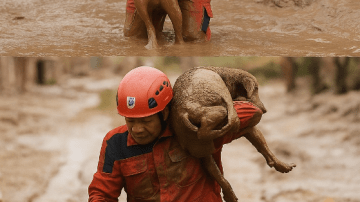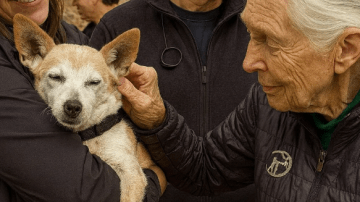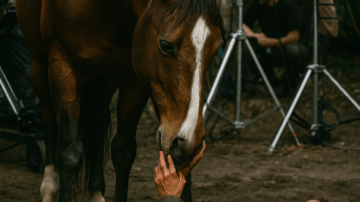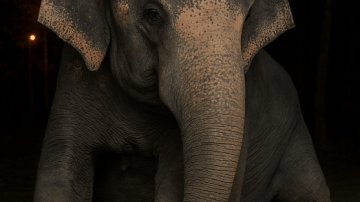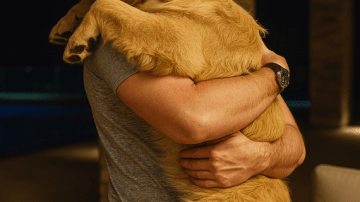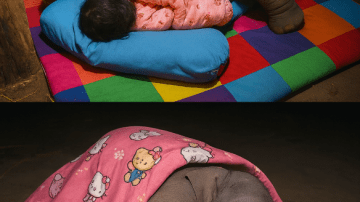He was once a hero. For years he stood watch, teeth bared at the darkness, ready to defend strangers who would never know his name. Soldiers called him “General”—a name given in affection and respect. He wasn’t just a military dog. He was a comrade, a protector, a quiet veteran who had endured long nights of cold, danger, and uncertainty.

And yet this is how we found him: chained to a post like a piece of trash, starving, trembling, and waiting to die.
General had spent his entire life protecting people. As a military guard dog, he had been trained to sacrifice himself if necessary, to hold his ground when others fled. He had guarded bases, sniffed out danger, and stood shoulder-to-shoulder with soldiers on deployment. When he retired, he was supposed to live out his remaining years in peace—warm, loved, and safe.
Instead, his retirement became a nightmare.
When we received the call, none of us knew what to expect. The report was vague: “There’s an old military dog in trouble.” But nothing could have prepared us for what we saw.
Hidden in a dark corner behind a crumbling shed was a dog who barely resembled the proud animal in his service photo. His body was gaunt and shaking from cold and fear. He was too weak to stand. The chain around his neck had eaten into his flesh, leaving a deep, infected groove. His skin was raw and swollen, crawling with maggots. His ribs jutted out like the slats of a broken fence.
He would not survive much longer.
With the help of local police, we cut the chain and lifted him gently into our arms. He didn’t resist. His eyes were half-closed, dull with exhaustion and pain. We promised him, right then, that the nightmare was over. His owner would face justice.

We rushed him to the nearest veterinary hospital. Even the experienced staff there gasped when they saw him. Years of neglect had left his body a wreck. X-rays suggested bone tumors in his paws and elbows, likely the result of chronic malnutrition and untreated injuries. He could barely walk. Every movement seemed to hurt.
The wound around his neck was far worse than it looked. It wasn’t just a superficial cut; the chain had bitten deeply, carving through muscle and skin. Before it could be stitched, it had to be cleaned and disinfected, inch by inch, to stop the spread of infection.
But the greatest wound was in his spirit. You could see it in his eyes: a deep disappointment, a quiet heartbreak. This was a dog who had given everything—his strength, his youth, his loyalty—and been rewarded with betrayal.
We pieced together the story of how this had happened. After retirement, General had been adopted by a soldier who had promised to care for him. But when the man began dating someone new, he handed the dog off to his family, and from there, the chain of care broke. Eventually, General was simply abandoned, left to starve and suffer.
It is hard to comprehend such cruelty.
And yet, even in his weakest moment, General was gentle. When we offered him food, he ate with quiet determination. There was no aggression, no bitterness. Only hunger. Only trust, fragile but still alive.

We vowed to give him what he had never truly known: dignity, comfort, and love.
The first few days were critical. We treated his wounds, shaved the fur from around his neck, and began a slow refeeding program. We spoke softly to him, letting him hear kindness instead of commands. Each day he grew a little stronger.
Then came the change.
A week later, his eyes were brighter. His tail began to wag when he saw us. His appetite returned with a vengeance. He started to put on weight; his ribs no longer stood out like prison bars. His wound began to close. The despair in his face began to lift, replaced by a glimmer of the proud dog he once had been.
He even started to play—tentatively at first, then with growing confidence. To see a dog who had endured so much cruelty begin to chase a ball again is to witness a kind of miracle.
We were overjoyed. And yet, beneath that joy was a slow-burning anger. How could anyone have done this to him? We filed our report with the authorities. We hoped the man responsible would be punished.
But cruelty has a way of slipping through cracks. The man evaded consequences and, shockingly, came to our shelter demanding his dog back.
We turned him away at the door.
Some people should never own a dog.
General will never again be treated as an object or a burden. He is ours now—our friend, our veteran, our family. He has a warm bed, good food, and a yard where he can feel the grass under his paws. He will never again know the sting of a chain cutting into his neck.

Today, when you meet him, you wouldn’t guess what he endured. He greets visitors with a wagging tail and bright eyes. He’s put on healthy weight. His fur has grown back over the scars. The old soldier has rediscovered joy.
But if you look closely, you can still see the story written on his body: the faint scar around his neck, the stiffness in his joints. These are reminders of what loyalty cost him—and of what we owe animals like him.
General’s story is a lesson. It’s about the hidden lives of working dogs who serve and protect but are too often discarded when they’re no longer useful. It’s about the quiet heroism of animals who give their all without complaint. And it’s about our responsibility to ensure they are honored, not betrayed, in their final years.
He was a soldier once. He stood watch while others slept. He kept his promise.
Now it is our turn to keep ours.
This is his home. We are his family. And for the rest of his days, General will be treated as what he truly is: a hero.

